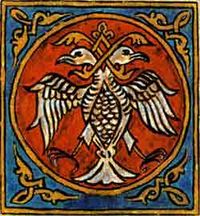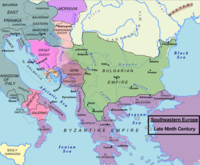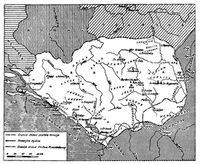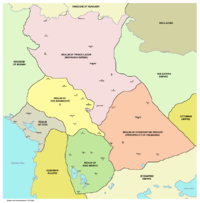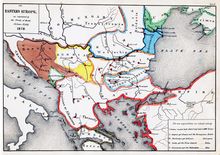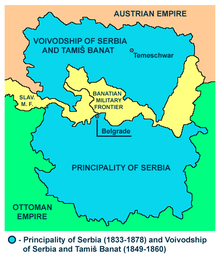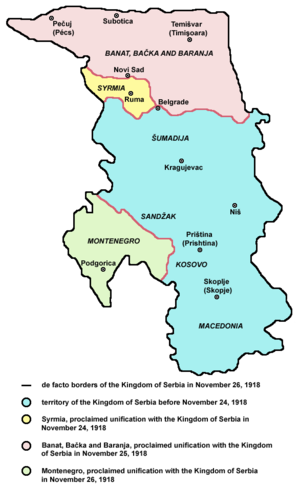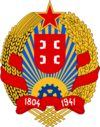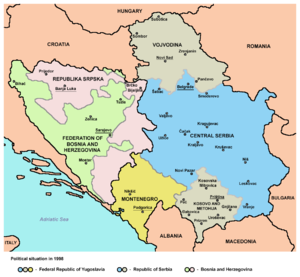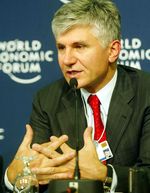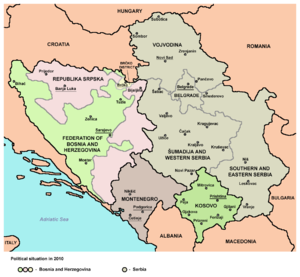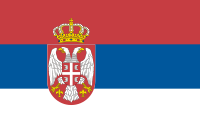تاريخ صربيا
تاريخ صربيا، كبلد، بدأ مع المستوطنات السلاڤية في البلقان، التي تأسست في القرن 6 على الأراضي التي كانت تحت الامبراطورية البيزنطية. على مدار القرون، تطورت صربيا إلى مملكة (1217)، ثم ضُمت إليه امبراطورية عام 1540. وقعت ثورات غير ناجحة أو محدودة متعددة ضد الحكم العثماني، وحصلت المناطق الشمالية على استقرار لفترة وجيزة في القرن 18. عام 1804 بدأت الثورة الصربية، والتي أدى إلى تحرير صربيا. عام 1918، تأسست يوغسلاڤيا كاتحاد للأمم السلاڤية الجنوبية. عام 1991، حُلت يوغسلاڤيا، واستمر الاتحاد مع صربيا والجبل الأسود. في 2006، تأسست "جمهورية صربيا".
. . . . . . . . . . . . . . . . . . . . . . . . . . . . . . . . . . . . . . . . . . . . . . . . . . . . . . . . . . . . . . . . . . . . . . . . . . . . . . . . . . . . . . . . . . . . . . . . . . . . . . . . . . . . . . . . . . . . . . . . . . . . . . . . . . . . . . . . . . . . . . . . . . . . . . . . . . . . . . . . . . . . . . . .
قبل التاريخ
العصر الروماني
العصر البيزنطي
العصور الوسطى (768–1459)
صربيا في عهد أسرة ڤلاستيميروڤچ
صربيا في عهد أسرة ڤويسلاڤليڤچ
صربيا في عهد أسرة نمانيچ
أفلح الژوپان Zhupan (الزعيم) ستفان نمانيا Stefan Nemanja في عام 1159 في إخضاع العشائر والأقاليم الصربية المختلفة لحكمه، فكان هو المؤسس الحقيقي لمملكة الصرب، التي ظلت خاضعة لحكم أسرته مائتي عام. وكان ابنه سافا Sava يؤدي للأمة أعمال كبير الأساقفة والحاكم السياسي في وقت واحد، فأصبح فيما بعد أعظم قديسيها منزلة في نفوس الأهلين.وكانت البلاد لا تزال فقيرة، حتى كانت القصور الملكية نفسها تقام من الخشب. وكانت لها فرصة بحرية مزدهرة هي مدينة راگوسا Ragusa (دوبروڤنيك Dubrovnik الحالية)، ولكن هذه المدينة كانت دولة مستقلة مفردة. أصبحت في عام 1221 خاضعة لحماية البندقية. واتخذ الفن الصربي في خلال هذين القرنين طرازاً خاصاً به وبلغ درجة عظيمة من الإتقان في هذا الطراز الخاص، نتبينهما في الصور والنقوش المرسومة على جدران كنيسة القديس بنتيليمون Panteleimon ذات الدير في نريز Nerez (حوالي عام 1164)، فهي تكشف عن واقعية مسرحية لم نعتدها في التصوير البيزنطي، وتسبق بقرن من الزمان بعض أساليب التصوير التي كانت في ظن الناس من ابتكار دشيو Duccio وجيتو Giotto. وتظهر في هذه الصور الجدارية وغيرها مما رسم في القرنين الثاني عشر والثالث عشر صور للملوك تنم عن فردية لا تضارعها فيها أية صورة بيزنطية قبل ذلك العهد. [1]
وبينما كانت بلاد الصرب في العصور الوسطى تسير نحو حضارة راقية، حطمت الاضطهادات والمروق من الدين وحدة الأمة، ولربما كان في وسعها لولا هذا أن توقف زحف الأتراك.
From late 12th century onwards, a new state called Raska, centred in present-day southern Serbia, rose to become the paramount Serb state. Over the 13th and 14th centuries, it ruled over the other Serb lands (the Hum, Travunia and Duklja/Zeta. During this time, Serbia began to expand eastward (toward Niš), southward into Kosovo and northern Macedonia and northward toward Srem and Macva for the first time. This shift away from the Adriatic coast brought Serbia increasingly under the influence of the Eastern Orthodox, although a substantial proportion of Catholics were found in the coastal regions. Although Europe had already experience the East-West Schism by this time, such a split was far less concrete than it is today, and Catholic Slavs in Bosnia and the Dalmatian coast practiced Christianity in a similar way to Orthodox Slavs – priests married, wore beards and gave liturgy in Slavic rather than Latin. By the beginning of the 14th century Serbs lived in three distinctly independent kingdoms- Dioclea, Rascia and Syrmia.[2][3][4]
Led by the Nemanjić dynasty, medieval Serbia reached its military, economic and legal climax. The مملكة صربيا was proclaimed in 1217. Direct result of this was the establishment of the Serbian Orthodox Church in 1219. In the same year Saint Sava published the first constitution in Serbia – Zakonopravilo (St. Sava's Nomocanon).
Stefan Dušan proclaimed the الامبراطورية الصربية in 1346. During Dušan's rule, Serbia reached its territorial, political and economical peak, proclaiming itself as the successor of the Byzantine Empire, and indeed was the most powerful Balkan state of that time. Tsar Dušan enacted the known Dušan's Code, an extensive constitution, and opened new trade routes and strengthened the state's economy. Serbia flourished, becoming one of the most developed countries and cultures in Europe. Medieval Serbia had a high political, economic, and cultural reputation in Europe. The Serbian identity has been profoundly shaped by the rule of this dynasty and its accomplishments, with the Serbian Orthodox Church who assumed the role of the national spiritual guardian.
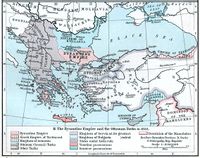
Before his sudden death, Stefan Dušan tried to organize a Crusade with the Pope against the threatening Turks. He died in December 1355 at the age 47. He was succeeded by his son Uroš, called the Weak, a term that might also apply to the state of the empire which slowly slided into a feudal anarchy. This was a period marked by the rise of a new threat: the Ottoman Turk sultanate which spread from Asia to Europe. They conquered Byzantium and then the other states in the Balkans.
سقوط صربيا
Two Barons in the Serbian region, Mrnjavčević brothers, gathered a large army to repel the Ottomans. They marched into Ottoman territory in 1371 to attack the Turks, but they were too self-confident. They built an overnight camp near the river Maritsa at Chernomen in today's Bulgaria, and started celebrating the victory in advance, and eventually got drunk. During the night, a detachment of Ottoman forces attacked the drunk Serbian knights and pushed them to the river. Most of the knights were either killed or drowned. This battle became known as the Battle of Maritsa. The result of this battle was that Serbs lost control over the south half of their former empire.
الاحتلال العثماني 1459–1878
الفتح العثماني
استمرّ السلطان العثماني مراد الثاني الغازي في جهاد الصرب على سنّة آبائه من قبل، فقد بدأ جهاده في شهر رمضان سنة خمس وعشرين وثمانمائة هجرية بمهاجمة القسطنطينية التي استعصت عليه فتركها متجهًا غربًا حتّى وصل إلى بلاد المجر، فجاهد ملكها وألزمه بالتوقيع على معاهدة تقضي عليه بالتخلّي عن أملاكه على شاطئ نهر الدانوب الأيمن بحيث يكون هذا النهر فاصلا بين الدولة العثمانية والمجر.
ولما رأى أمير الصرب المدعو جورج برنكوفيتش أنه لا يقوى على مقاومة المسلمين قبل أن يدفع جزية سنوية قدرها خمسون ألف دوك ذهبي، وأن يقدّم للسلطان فرقة من جنوده وقت الحرب، وأن يزوّجه ابنته، وأن يتنازل للمسلمين عن بلدة كروشيفاس وسط بلاد الصرب، لتكون حصنًا منيعًا تحتمي به القوة الإسلامية المهيمنة على بلاد الصرب. واستمر هذا الصلح حتى سنة ثلاث وأربعين وثمانمائة؛ حيث عصى ملك الصرب، فكانت عاقبة عصيانه إرسال جيش إسلامي فتح مدينة سمندرية التي تبعد عن بلغراد مسافة خمسة وأربعين كيلاً، ثمّ سار مراد بنفسه فحاصر مدينة بلغراد، ولكن ملك الصرب فرّ منها واستمر الحصار مدة ستة أشهر ولم يتمكن المسلمون من فتحها.
وفى سنة خمس وخمسين وثمانمائة هجرية توفِّيَ السلطان مراد، وخلفه على الحكم في الدولة العثمانية ابنه السلطان محمد الفاتح -رحمه الله- فواصل الجهاد في سبيل الله، وعلى الرغم من أنّ فتحه القسطنطينية هو أعظم أعماله، بل أعظم أعمال العثمانيين إلا أننا لن نتحدث عنه في هذا المقام.
اتجه محمد الفاتح بعد إتمام الفتح إلى بلاد الصرب وفرض عليهم جزية سنوية مقدارها ثمانون ألف دوك ذهبي، وفي سنة ثمان وخمسين وثمانمائة عاد إليها مرة أخرى بجيش كثيف واخترقها من جنوبها إلى شمالها دون أن يلقى أيّة معارضة، ووصل إلى بلغراد فحاصرها مرة أخرى ولم يتمكن من فتحها.
وفي سنة سبع وستين وثمانمائة هجرية حارب محمد الفاتح بلاد البوسنة لامتناع أميرها النصراني عن دفع الجزية، فأسره هو وولده ودانت له جمع بلاد البوسنة، وتدّخل ملك المجر لأخذها من المسلمين فهزموه هزيمة شنيعة وقُتِل معظم جيشه، وكان من نتائج ذلك أن جُعلت البوسنة ولاية من ولايات الدولة العثمانية، وأسلم أغلب أهلها وانضم ثلاثون ألفًا من شبابها إلى جيش الدولة العثمانية بعد إسلامهم.
وتوفِّيَ السلطان محمد الفاتح سنة ست وثمانين وثمانمائة هجرية بعد أن حقّق للإسلام انتصارات عظيمة في أوروبا، وانتشر الإسلام على يديه في مناطق شاسعة منها، وانشغلت الدولة العثمانية فترة من الزمن بالحروب التي أثارها الصفويون الشيعة على حدودها الشرقية، وقد ثبت عن طريق الوثائق التاريخية أنّ ذلك بتدبير من الأوروبيين النصارى لإشغال العثمانيين السنة وإيقاف زحفهم في أوروبا، ثم انتهت الحرب الصفوية العثمانية بالصلح، ثمّ عادوا إلى الفتح ونشر الإسلام من جديد.
كان ذلك في عهد السلطان سليمان القانوني؛ ففي شهر شعبان من سنة سبع وعشرين وتسعمائة هجرية أقدم ملك الصرب على قتل سفير المسلمين لديه، فاستشاط السلطان لذلك غضبًا وأمر بتجهيز الجيوش الإسلامية وجمع كل ما يلزم من المئونة والذخائر وسار هو بنفسه لمحاربتهم، وأرسل فرقة إلى بلغراد فحاصرها، ولم يدم الحصار طويلاً إذ سرعان ما استسلم أهلها في الخامس والعشرين من رمضان، ودخلها السلطان فصلّى في إحدى كنائسها صلاة الجمعة. وصارت هذه المدينة -التي كانت أمنع حصن للنصارى ضد تقدم الدولة الإسلامية- أكبر مساعد لهم على فتح ما وراء الدانوب.
وأعلن عن هذا الانتصار العظيم إلى جميع الولاة وملوك أوروبا، وعاد السلطان سليمان القانوني إلى عاصمة الدولة الإسلامية إسلامبول، وأرسل إليه الملوك والرؤساء يهنئونه بهذا الفتح العظيم.
وهكذا استطاع المسلمون إخضاع ما يُعرف سابقا بيوغسلافيا وحاليًّا بصربيا، وظلّت تابعة لهم سنين عديدة حكمها المسلمون بالعدل والرحمة، مما حبّبهم إلى رعاياها فاعتنق كثير منهم الإسلام عن رغبة وبحرية، وظلّوا عليه إلى وقتنا الحاضر، حيث يعمل النصارى على قتلهم أو طردهم من تلك البلاد مع أنّها بلادهم وديارهم.
المصادر: 1- احمد يوسف القرماني : أخبار الدول وآثار الأول في التاريخ 1282هـ 2- محمد فريد المحامي : تاريخ الدولة العلية العثمانية : ط6. 3- يوسف أصاف : تاريخ سلاطين آل عثمان تحقيق بسام الجابي دار البصائر.
. . . . . . . . . . . . . . . . . . . . . . . . . . . . . . . . . . . . . . . . . . . . . . . . . . . . . . . . . . . . . . . . . . . . . . . . . . . . . . . . . . . . . . . . . . . . . . . . . . . . . . . . . . . . . . . . . . . . . . . . . . . . . . . . . . . . . . . . . . . . . . . . . . . . . . . . . . . . . . . . . . . . . . . .
the Serbian despotate
استمرت بوسنة العصور الوسطى وزيتا حتى 1496. وقد أعيد بعث إمارة صربية بعد سنوات من سقوط the Serbian despotate وكان البعث على يد أسرة برانكوڤتش وظلت كتابع للمجر في ما هو الآن ڤويڤودينا والمجر الشمالية ورومانيا. وقد حكمها النبلاء الصرب المنفيون حتى 1540 حين سقطت في يد العثمانيين.
المقاطعة العثمانية 1459–1803
آخر حرب عثمانية نمساوية كانت تلك المسماة حرب دوبيتسا (1788–91)، حين طالبت النمسا المسيحيين في البوسنة أن يثوروا على العثمانيين. No wars were fought afterwards until the 20th century that marked the fall of both Austrian and Ottoman empires, staged together by the European powers/imperialism just after World War I.
الثورة الصربية 1804–1817

حصلت صربيا على الاستقلال الذاتي عن الدولة العثمانية في انتفاضتين في 1804 (بقيادة Đorđe Petrović – Karađorđe) و 1815 (بقيادة ميلوش اوبرنوڤتش)، بالرغم من أن القوات العثمانية واصلت حراسة العاصمة، بلگراد، حتى 1867. The Turkish Empire was already faced with a deep internal crisis without any hope of recuperating. This had a particularly hard effect on the orthodox nations living under its rule. The Serbs launched not only a national revolution but a social one as well.
الإمارة الذاتية 1817–1878
في 1817 حصلت إمارة صربيا على استقلال الأمر الواقع من الدولة العثمانية.
صربيا المستقلة 1878–1918
The Autonomous Principality became an internationally recognized independent country following the Russo-Turkish War in 1878. Serbia remained a principality or kneževina (knjaževina), until 1882 when it became a Kingdom, during which the internal politics revolved largely around dynastic rivalry between the Obrenović and Karađorđević families.
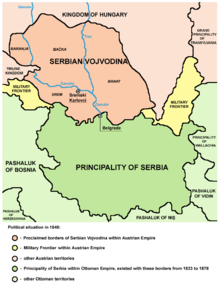
صربيا في الحرب العالمية الأولى
Despite its small size and population of 4.6 million, Serbia had the most effective manpower mobilization of the war, and had a highly professional officer corps. It called 350,000 men to arms, of whom 185,000 were in combat units.[5] However the casualties and expenditure of munitions in the Balkan Wars left Serbia depleted and dependent on France for supplies. Austria invaded twice in 1914 and was turned back.
The Entente promised the territories of Srem, Bačka, Baranja, eastern Slavonia, Bosnia and Herzegovina and eastern Dalmatia to Serbia as a reward after the war. Having recuperated on Corfu the Serbian Army returned to combat on the Thessaloniki front together with other Entente forces. Serbia suffered 1,264,000 casualties—28% of its population of 4.6 million, which also represented 58% of its male population—a loss from which it never fully recovered.
يوغوسلاڤيا الملكية 1918–1941
صربيا في الحرب العالمية الثانية 1941–1944
يوغوسلاڤيا الشيوعية 1945–1992
حكم تيتو 1945–1980
The 1974 constitution produced a significantly less centralized federation, increasing the autonomy of Yugoslavia's republics as well as the autonomous provinces of Serbia.
. . . . . . . . . . . . . . . . . . . . . . . . . . . . . . . . . . . . . . . . . . . . . . . . . . . . . . . . . . . . . . . . . . . . . . . . . . . . . . . . . . . . . . . . . . . . . . . . . . . . . . . . . . . . . . . . . . . . . . . . . . . . . . . . . . . . . . . . . . . . . . . . . . . . . . . . . . . . . . . . . . . . . . . .
الانحدار والسقوط 1980–1992
Rump Yugoslavia 1992–2003
The two remaining republics of Yugoslavia, صربيا والجبل الأسود، تشكلت في 28 أبريل 1992 في اتحاد جديد سُمـِّي جمهورية يوغوسلاڤيا الاتحادية.
سنوات ميلوشڤچ 1992–2000
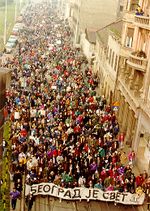
Following the breakup of Yugoslavia, the Federal Republic of Yugoslavia (FRY) was established in 1992 as a federation. In 2003, it was reconstituted as a political union called the State Union of Serbia and Montenegro (SCG).
On 5 October 2000, Slobodan Milošević was forced to concede defeat after days of mass protests all across Serbia.
صربيا الديمقراطية 2000–2003
صربيا والجبل الأسود 2003–2006
In February 2003, the Constitutional Charter was finally ratified by both republics, and the FRY Parliament and the name of the country was changed from Federal Republic of Yugoslavia to Serbia and Montenegro. Under the new Constitutional Charter, most federal functions and authorities devolved to the republic level. The office of President of the Federal Republic of Yugoslavia, held by Vojislav Koštunica, ceased to exist once Svetozar Marović was elected President of Serbia and Montenegro.
On 12 March 2003, Serbian Prime Minister Zoran Đinđić was assassinated. The newly formed union government of Serbia and Montenegro reacted swiftly by calling a state of emergency and undertaking an unprecedented crackdown on organized crime which led to the arrest of more than 4,000 people.
صربيا المستقلة 2006–الحاضر
Since 1996, Montenegro began to sever economic ties with Serbia as it formed a new economic policy واتخذت المارك الألماني كعملة لها. Subsequent governments of Montenegro carried out pro-independence policies, and political tensions with Serbia simmered despite political changes in بلگراد. Also, separatist Albanian paramilitaries began a steady escalation of violence in 1998. The question whether the Federal Yugoslav state would continue to exist became a very serious issue to the government.
A referendum was held on 28 and 29 October 2006 on a proposed draft of the new Constitution of Serbia, which was approved.[6] The constitution is Serbia's first as an independent state since the Kingdom of Serbia's 1903 constitution.
نزاع كوسوڤو
On 17 February 2008, the Kosovo parliament unilaterally proclaimed independence from Serbia to mixed international reactions. The declaration was officially recognized by the U.S., Austria, Great Britain, Germany, France, Turkey and dozen other countries. Serbia, Russia, China, Spain, India, Brazil, Greece, Romania and other countries oppose this declaration and consider it illegal. In July 2010, the United Nations International Court of Justice deemed the separation of Kosovo legal, and Kosovo officials plan a 2011 application to the UN.[7][8]
الانضمام للاتحاد الاوروبي
A Stabilisation and Association Agreement (SAA) was signed in 2008 and is expected to enter into force in 2011.
طالع أيضاً
- تفكك يوغوسلاڤيا
- عواصم صربيا
- Corpus Juris Civilis
- Dušan's Code
- تاريخ اوروبا
- سياسة صربيا
- تاريخ يوغوسلاڤيا
- League of Communists of Yugoslavia
- قائمة رؤساء صربيا
- قائمة رؤساء وزراء صربيا
- قائمة ملوك صربيا
- قائمة رؤوس دولة يوغوسلاڤيا
- قائمة رؤساء وزراء يوغوسلاڤيا
- التاريخ العسكري لصربيا
- صربيا
- الصرب
- الامبراطورية الصربية
- Serbian Despotate
- Zakonopravilo
المراجع
ملاحظات
الهامش
- ^ ديورانت, ول; ديورانت, أرييل. قصة الحضارة. ترجمة بقيادة زكي نجيب محمود.
- ^ "Fresco of King Mihailo". Serb Land of Montenegro.
- ^ "Serbian Medieval History". Serbian Unity Congress. 2006.
- ^ Nenad Šerović. "Stefan Tvrtko I Kotromanić" (in Serbian). Projekat Rastko: Biblioteka srpske kulture.
{{cite web}}: CS1 maint: unrecognized language (link) - ^ Stevenson, Cataclysm p 59
- ^ "Serbia backs draft constitution". BBC. 30 October 2006. Retrieved 2006-10-30.
- ^ http://www.morningstaronline.co.uk/index.php/news/content/view/full/93190
- ^ http://www.setimes.com/cocoon/setimes/xhtml/en_GB/newsbriefs/setimes/newsbriefs/2010/07/25/nb-04
ببليوگرافيا
- Hehn, Paul N. (1971). "Serbia, Croatia and Germany 1941-1945: Civil War and Revolution in the Balkans". Canadian Slavonic Papers. University of Alberta. 13 (4): 344–373. Retrieved 8 April 2012.
{{cite journal}}: Cite has empty unknown parameters:|month=and|editorlink=(help) - Pavlowitch, Stevan K. (2002). Serbia: the History behind the Name. London: C. Hurst & Co. Publishers. ISBN 978-1-85065-476-6.
للاستزادة
- Hoptner; J. B. Yugoslavia in Crisis, 1934-1941 (Columbia University Press, 1963) online edition
- Mitrovic, Andrej. Serbia's Great War 1914-1918 (2007)
- Popov, Nebojsa. The Road to War in Serbia: Trauma and Catharsis (Central European University Press, 2000) on 1991-95 online edition
- Ramet, Sabrina P., and Ola Listhaug, eds. Serbia and the Serbs in World War Two (2011)
- Temperley, Harold W. V. History of Serbia (1917) 359 pp online edition
وصلات خارجية
- History of Medieval Serbs (Video in serbian)
- History of Serbia
- Atlas – historical maps of Serbia (Wikimedia Commons)
- Kosovo: Historical Survey: From Medieval Times to NATO Attack by Srđa Trifković
- The Kosovo Crisis: Origins and History by Carl K. Savich
- Serbian Unity Congress Serbian history page
- Catholic Encyclopedia:Servia

